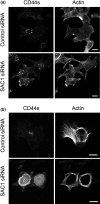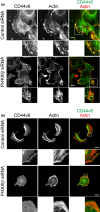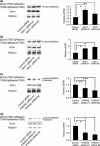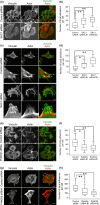Regulation of CD44 expression and focal adhesion by Golgi phosphatidylinositol 4-phosphate in breast cancer
- PMID: 27178239
- PMCID: PMC4946718
- DOI: 10.1111/cas.12968
Regulation of CD44 expression and focal adhesion by Golgi phosphatidylinositol 4-phosphate in breast cancer
Abstract
CD44, a transmembrane receptor, is expressed in the standard or variant form and plays a critical role in tumor progression and metastasis. This protein regulates cell adhesion and migration in breast cancer cells. We previously reported that phosphatidylinositol-4-phosphate (PI(4)P) at the Golgi regulates cell migration and invasion in breast cancer cell lines. In this study, we showed that an increase in PI(4)P levels at the Golgi by knockdown of PI(4)P phosphatase SAC1 increased the expression of standard CD44, variant CD44, and ezrin/radixin phosphorylation and enhanced the formation of focal adhesions mediated by CD44 and ezrin/radixin in MCF7 and SK-BR-3 cells. In contrast, knockdown of PI 4-kinase IIIβ in highly invasive MDA-MB-231 cells decreased these factors. These results suggest that SAC1 expression and PI(4)P at the Golgi are important in tumor progression and metastasis and are potential prognostic markers of breast cancers.
Keywords: Breast cancer; CD44; SAC1; focal adhesion; phosphatidylinositol-4-monophosphate.
© 2016 The Authors. Cancer Science published by John Wiley & Sons Australia, Ltd on behalf of Japanese Cancer Association.
Figures







Similar articles
-
Phosphatidylinositol 4-phosphate in the Golgi apparatus regulates cell-cell adhesion and invasive cell migration in human breast cancer.Cancer Res. 2014 Jun 1;74(11):3054-66. doi: 10.1158/0008-5472.CAN-13-2441. Epub 2014 Apr 4. Cancer Res. 2014. PMID: 24706697
-
Sac1 lipid phosphatase and Stt4 phosphatidylinositol 4-kinase regulate a pool of phosphatidylinositol 4-phosphate that functions in the control of the actin cytoskeleton and vacuole morphology.Mol Biol Cell. 2001 Aug;12(8):2396-411. doi: 10.1091/mbc.12.8.2396. Mol Biol Cell. 2001. PMID: 11514624 Free PMC article.
-
A novel mechanism of regulating breast cancer cell migration via palmitoylation-dependent alterations in the lipid raft affiliation of CD44.Breast Cancer Res. 2014 Feb 10;16(1):R19. doi: 10.1186/bcr3614. Breast Cancer Res. 2014. PMID: 24512624 Free PMC article.
-
The Great Escape: how phosphatidylinositol 4-kinases and PI4P promote vesicle exit from the Golgi (and drive cancer).Biochem J. 2019 Aug 28;476(16):2321-2346. doi: 10.1042/BCJ20180622. Biochem J. 2019. PMID: 31462439 Review.
-
[Advances of the Role of Ezrin in Migration and Invasion of Breast Cancer Cells].Sheng Li Ke Xue Jin Zhan. 2016 Feb;47(1):21-6. Sheng Li Ke Xue Jin Zhan. 2016. PMID: 27424401 Review. Chinese.
Cited by
-
Dysregulation of PI4P in the trans Golgi regions activates the mammalian Golgi stress response.J Biol Chem. 2025 Jan;301(1):108075. doi: 10.1016/j.jbc.2024.108075. Epub 2024 Dec 13. J Biol Chem. 2025. PMID: 39675715 Free PMC article.
-
SWAP-70 promotes glioblastoma cellular migration and invasion by regulating the expression of CD44s.Cancer Cell Int. 2019 Nov 21;19:305. doi: 10.1186/s12935-019-1035-3. eCollection 2019. Cancer Cell Int. 2019. PMID: 31832018 Free PMC article.
-
Role of the Mosaic Cisternal Maturation Machinery in Glycan Synthesis and Oncogenesis.Front Cell Dev Biol. 2022 Apr 6;10:842448. doi: 10.3389/fcell.2022.842448. eCollection 2022. Front Cell Dev Biol. 2022. PMID: 35465326 Free PMC article. Review.
-
Activation of CD44 signaling in leader cells induced by tumor-associated macrophages drives collective detachment in luminal breast carcinomas.Cell Death Dis. 2022 Jun 9;13(6):540. doi: 10.1038/s41419-022-04986-4. Cell Death Dis. 2022. PMID: 35680853 Free PMC article.
-
Identification and validation of Golgi apparatus-related signature for predicting prognosis and immunotherapy response in breast cancer.J Cancer Res Clin Oncol. 2024 Feb 1;150(2):61. doi: 10.1007/s00432-024-05612-w. J Cancer Res Clin Oncol. 2024. PMID: 38300336 Free PMC article.
References
-
- Fox SB, Fawcett J, Jackson DG et al Normal human tissues, in addition to some tumors, express multiple different CD44 isoforms. Cancer Res 1994; 54: 4539–46. - PubMed
-
- Kaufmann M, Heider KH, Sinn HP, von Minckwitz G, Ponta H, Herrlich P. CD44 variant exon epitopes in primary breast cancer and length of survival. Lancet 1995; 345: 615–19. - PubMed
-
- Barshishat M, Ariel A, Cahalon L, Chowers Y, Lider O, Schwartz B. TNFalpha and IL‐8 regulate the expression and function of CD44 variant proteins in human colon carcinoma cells. Clin Exp Metastasis 2002; 19: 327–37. - PubMed
MeSH terms
Substances
LinkOut - more resources
Full Text Sources
Other Literature Sources
Medical
Research Materials
Miscellaneous

